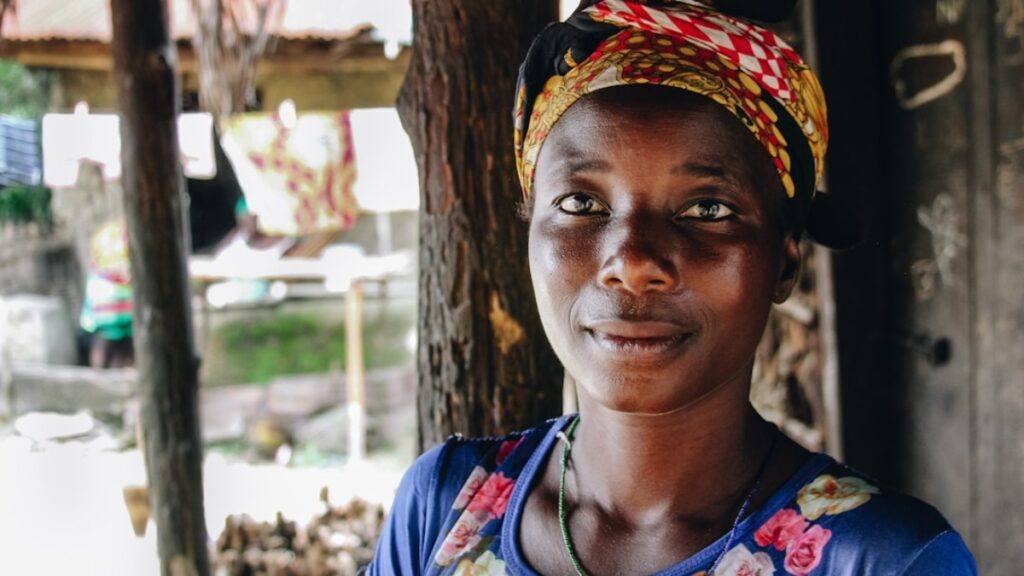
Part 1: A Seed is Sown
The late afternoon sun cast long shadows across the dusty plains as Panyim trudged back from the university. He kicked at a pebble, his frustration growing with every step. He’d just finished a literature class, and Professor James’ words echoed in his head, “The publishing industry is a tough nut to crack, Panyim. But hey, if your story’s strong enough…” The professor’s voice trailed off, leaving Panyim feeling utterly deflated.
Reaching his hut, he found Nyakor, his girlfriend, braiding her hair under the shade of a nearby baobab tree. Her laughter drifted towards him, a welcome sound in his gloomy mood. He slumped onto the woven mat beside her, letting out a long sigh.
Nyakor, ever perceptive, noticed his dejection. “What troubles you, Panyim?” she asked, her voice laced with concern.
He hesitated, then blurted out, “Professor James. He was talking about publishing a book, and it sounds impossible.”
Nyakor raised an eyebrow, a playful smile tugging at her lips. “Impossible for whom? You, the boy who can spin stories that make even the elders gasp?”
Panyim managed a weak smile. “He made it seem like only the most famous writers get published.”
Nyakor’s smile widened. “Maybe the traditional way is tough, but there’s another path, Panyim. A path where you hold the reins.”
Panyim’s ears perked up. “Another path? What do you mean?”
Nyakor’s eyes sparkled with mischief. “Have you heard of self-publishing?”
Panyim shook his head, his curiosity piqued. “Self-publishing? Sounds like you’re making it up.”
Nyakor chuckled. “Not at all! It’s where you, the writer, take charge. You edit your story, design your cover, and publish it online for the whole world to see.”
Panyim’s jaw dropped. “The whole world? But wouldn’t that cost a fortune?”
Nyakor shook her head. “Not necessarily. There are platforms online, like Amazon KDP, that make it accessible for everyone. You just upload your manuscript, and they handle the rest.”
Panyim’s mind raced with possibilities. “A manuscript? That’s the finished story, right?”
“Exactly,” Nyakor confirmed. “But before you get ahead of yourself, there’s work to be done. Think of it like planting sorghum. You wouldn’t just toss seeds on barren ground, would you?”
Panyim shook his head, a grin slowly spreading across his face. “No, you prepare the soil, make sure it’s fertile.”
Nyakor clapped her hands, her smile mirroring his. “Precisely! Your story is the seed, Panyim. But before you publish, you need to nurture it, make sure it’s polished and ready to take root in the hearts of readers.”
The weight of Professor James’ words seemed to lift from Panyim’s shoulders. Self-publishing wasn’t a dead end, it was a new beginning. He leaned closer to Nyakor, his eyes shining with newfound determination. “Teach me, Nyakor. Teach me everything you know about this self-publishing path.”
Nyakor’s smile turned into a triumphant grin. “With pleasure, my writer. Let’s make your stories bloom for the world to see!”

Part 2: Building the Foundation
Sunlight streamed through the window of Nyakor’s hut, illuminating the laptop screen where a blinking cursor mocked Panyim. He chewed on his bottom lip, staring at the blank document titled ‘The Nile Whispers’. “This is harder than it looks,” he mumbled, frustration creeping into his voice.
Nyakor, perched beside him, patted his shoulder gently. “It takes time, Panyim. Remember, you’re building the foundation of your book. A strong foundation ensures your story stands tall.”
He sighed. “Professor James made it seem so easy. Just write a compelling story, he said.”
Nyakor chuckled. “Professors love their traditional methods. But self-publishing is different. You’re not just a writer here, Panyim, you’re the editor, the publisher, the marketer – all rolled into one.”
Panyim’s eyes widened. “All that? But where do I even start?”
Nyakor leaned closer, her eyes sparkling with excitement. “First things first, your manuscript. That’s your completed story, the heart and soul of your book.”
Panyim grimaced. “Completed? My stories are always changing, evolving in my head.”
Nyakor laughed. “I know, that’s the beauty of them! But for publishing, you need a fixed version, a polished gem.”
“Polished?” Panyim echoed. “Like how Mama smoothes the gourds before painting them?”
“Exactly!” Nyakor exclaimed, snapping her fingers. “There you go! You already have an eye for detail. Now, before you polish, you need a draft. Have you written anything down for ‘The Nile Whispers’?”
Panyim’s face flushed. “Well, there’s the legend of the talking catfish I started a while back…”
Nyakor’s smile widened. “A talking catfish! Panyim, that’s brilliant! Now, get that story flowing. Write it all down, even the rough bits. Don’t worry about perfection yet, just capture the essence of your tale.”
Panyim’s apprehension eased slightly. “So, it’s okay if it’s not perfect the first time?”
Nyakor squeezed his hand. “Absolutely! That’s where editing comes in. Once you have a complete draft, you polish it, refine it, make sure it shines. Think of it like smoothing those gourds with sandpaper.”
Panyim’s brow furrowed. “Editing? That sounds scary.”
Nyakor chuckled. “It can be, but it’s also magical. A good editor helps you see your story with fresh eyes, catches typos, and makes sure your sentences flow like the Nile itself.”
Panyim pondered this. “Maybe I could ask Akuch, my literature classmate? She always has great feedback on my essays.”
Nyakor’s smile faltered slightly. “Akuch is great, but for publishing, you might want to consider a professional editor. They have a trained eye for spotting weaknesses and can help elevate your work.”
Panyim’s shoulders slumped. “A professional editor? But wouldn’t that cost a lot?”
Nyakor patted his hand reassuringly. “There are options, Panyim. You can find freelance editors online, or maybe even participate in critique swaps with other aspiring authors. We’ll figure it out together.”
Hope rekindled in Panyim’s eyes. “Together? You’ll help me with all this?”
Nyakor grinned. “Always. Remember, you’re not alone on this journey, my writer. We’ll build this book one step at a time, brick by literary brick.”

Part 3: The Power of Words and Images
Panyim squinted at the laptop screen, his brows furrowed in concentration. He’d spent hours poring over Nyakor’s crash course on cover design, but the blank document mocked him. “This is harder than catching a lungfish with your bare hands,” he grumbled.
Nyakor, ever-observant, leaned over and placed a hand on his shoulder. “Easy there, writer. Designing a cover is like crafting a spear – it needs to be both beautiful and functional.”
Panyim sighed. “Beautiful, sure, but functional? How does a picture function?”
Nyakor chuckled. “A good cover does more than just look pretty, Panyim. It’s your first impression, a silent salesman that grabs a reader’s attention and tells them what your book is about.”
Panyim’s eyes widened. “Like a riddle carved into a calabash?”
Nyakor’s smile widened. “Exactly! Your cover should be a riddle that begs to be solved. Now, ‘The Nile Whispers’ – what kind of whispers are these? Are they secrets of the river? Warnings from the ancestors?”
Panyim tapped his chin thoughtfully. “Maybe a mixture of both. The Nile holds so many stories, some joyful, some filled with sorrow.”
Nyakor nodded enthusiastically. “Perfect! So, what visuals represent these whispers? The Nile itself, of course, but what else?”
Panyim closed his eyes, picturing the stories swirling in his head. “Maybe a lone papyrus boat sailing down the river, under a starry sky. Or perhaps a wise old catfish emerging from the water, its whiskers like secrets waiting to be unraveled.”
Nyakor’s eyes sparkled. “Oh, Panyim, those are fantastic ideas! The papyrus boat evokes a sense of mystery and journey, while the catfish adds a touch of magic and folklore. But remember, simplicity is key. Too many elements can clutter the message.”
Panyim pondered this, tapping his fingers on the table. “So, a clean background with the papyrus boat silhouetted against the starry sky? And maybe a subtle catfish fin breaking the waterline?”
Nyakor clapped her hands, a wide grin on her face. “Yes! That sounds absolutely stunning! Now, the next step is finding a way to create this cover. There are online platforms where you can find freelance designers, or maybe you know someone with a creative eye.”
Panyim scratched his head. “There’s my cousin, Atem. He’s always sketching landscapes and animals. Maybe he could translate my ideas into a real image.”
Nyakor beamed. “Brilliant! Remember, communication is key. Show Atem your story, explain the emotions you want to evoke, and trust his artistic vision.”
“Emotions?” Panyim echoed, a hint of confusion in his voice. “What kind of emotions?”
Nyakor sat back, her eyes twinkling. “Think about the feelings your story evokes, Panyim. Does it make you feel wonder? Awe? Maybe a touch of sadness? The cover should hint at these emotions, drawing the reader in.”
Panyim closed his eyes, picturing the stories swirling in his head. “Wonder, definitely. And a sense of peace, like the calm water after a long journey.”
Nyakor smiled knowingly. “Perfect. Now go show Atem your vision, Panyim. Let’s see him bring those Nile whispers to life on a cover that will make readers stop and say, ‘I have to read this book!'”

Part 4: Spreading the Seed
Panyim scrolled through his phone, a nervous energy buzzing through him. It had been weeks since he’d uploaded his manuscript to Amazon KDP, his heart pounding with every step of the process. Now, with the launch day mere hours away, his anxiety reached a fever pitch.
He glanced across the room at Nyakor, who was busy setting up their makeshift marketing headquarters – a woven mat spread beneath the shade of the baobab tree, Nyakor’s laptop at the center, and a steaming pot of tea beside it.
“Ready, Nyakor?” he asked, his voice barely a whisper.
Nyakor looked up, her eyes sparkling with excitement. “Ready as I’ll ever be, writer! Today, we unleash ‘The Nile Whispers’ on the world!”
Panyim took a deep breath, trying to quell the nervous butterflies fluttering in his stomach. “What if nobody reads it? What if my stories aren’t good enough?”
Nyakor scooted closer, placing a warm hand on his. “Panyim, your stories are magic. You’ve poured your heart and soul into them, woven the beauty and wisdom of our people into every word. Don’t you dare doubt that.”
Her words were a balm to his anxieties. He squeezed her hand back, a grateful smile spreading across his face. “Thanks, Nyakor. You’re the best.”
Nyakor winked. “Now, let’s get down to business. We’ve got a multi-pronged attack planned to spread the word about your book.”
Panyim’s eyes widened. “Multi-pronged attack?”
Nyakor chuckled. “Think of it like a fisherman casting his net. The wider you cast, the more readers you might catch.”
“I like that,” Panyim said, his nervousness slowly transforming into determination. “So, what’s the first prong?”
Nyakor tapped her laptop screen. “Social media, of course! We’ll create a buzz on Facebook and Instagram. Post captivating snippets from your story, beautiful pictures of the Nile – remember those stunning shots you took last summer?”
Panyim grinned. “The ones with the lotus flowers blooming? Perfect!”
Nyakor nodded. “Exactly! We’ll use relevant hashtags, like #NileStories or #AfricanLiterature, to connect with potential readers who are interested in these themes.”
Panyim’s brows furrowed. “Hashtags? Like those weird symbols people use?”
Nyakor chuckled. “Not exactly weird, Panyim. Think of them like keywords people search for online. Using relevant ones helps readers discover your book.”
“Like breadcrumbs leading them to the Nile?” Panyim asked, a playful glint in his eyes.
Nyakor threw her head back and laughed. “Exactly! But social media isn’t enough. We need to engage with other readers and authors. Leave comments on book blogs, join online writing communities, strike up conversations about stories and the power of self-publishing.”
Panyim’s smile faltered slightly. “Talking to strangers online? That makes me nervous.”
Nyakor squeezed his hand reassuringly. “Think of it like sitting around a virtual campfire, sharing stories and experiences. Most people in the writing community are friendly and supportive.”
“A virtual campfire,” Panyim repeated, the idea growing on him. “I like that.”
Nyakor grinned. “Great! And lastly, we can’t forget the power of a good book trailer. It’s like a movie trailer for your book, a short video that captures the essence of your story and entices viewers to read more.”
Panyim’s eyes widened. “A video? But how do we make one?”
Nyakor tapped her chin thoughtfully. “We can film some scenes ourselves – the Nile at sunset, close-ups of local crafts that represent your stories. We can even ask Atem, your artistic cousin, to help with some illustrations.”
Panyim’s face lit up. “Atem would love that! He’s always up for a creative challenge.”
Nyakor chuckled. “See? With a little creativity and collaboration, we can create a captivating book trailer that will draw readers in like moths to a flame.”
Panyim stood up, a newfound confidence radiating from him. “Social media, online communities, a book trailer… Nyakor, this is brilliant! We’re going to make a splash with ‘The Nile Whispers’.”
Nyakor reached out and bumped his fist playfully. “That’s the spirit, writer! Now, let’s get started. The world is waiting to hear your stories!”

Part 5: Reap What You Sow
The early morning sun cast long shadows across the dusty plains as Panyim refreshed the Amazon KDP page for the hundredth time. His heart hammered in his chest, a mix of anticipation and fear. Nyakor sat beside him, her eyes glued to the screen as well. Finally, with a click and a flourish, the page changed.
“There it is!” Nyakor exclaimed, jumping to her feet and throwing her arms around Panyim. “‘The Nile Whispers’ is officially live!”
Panyim let out a shaky breath, a wave of relief washing over him. He stared at the cover – Atem’s masterful depiction of the papyrus boat silhouetted against a starry sky, with a hint of a catfish fin breaking the waterline – a perfect representation of his story.
“It’s beautiful,” he whispered, a lump forming in his throat.
Nyakor squeezed his hand. “It is, Panyim. And it’s all yours. You did this.”
The day passed in a blur of activity. They shared the news on social media, their carefully crafted posts and captivating snippets from the story drawing immediate attention. Messages started trickling in – congratulations from friends and family, curious inquiries from strangers intrigued by the title and cover art.
Days turned into weeks, and the first reviews began to appear. Panyim held his breath as he read the first one – a glowing review praising the vivid imagery and the heartfelt portrayal of Nuer culture. A wave of pride washed over him, quickly followed by a nervous flutter in his stomach.
“What if the next one isn’t so good?” he mumbled, chewing on his lower lip.
Nyakor, perched beside him, reached over and gently shut the laptop. “Don’t read reviews all day, Panyim. Take them in stride. You can’t please everyone, but some will truly connect with your stories.”
The next morning, another review popped up – a more critical one, pointing out a few plot inconsistencies. Panyim felt a pang of disappointment, but Nyakor was there to soften the blow.
“See, constructive criticism,” she said, pointing at the screen. “This is how you learn and grow as a writer.”
Panyim frowned. “But it feels like a slap in the face.”
Nyakor smiled gently. “Not at all. Use it as an opportunity to improve your writing. Maybe rewrite that specific scene, tighten the plot a little. Remember, even the most celebrated authors receive criticism.”
Taking a deep breath, Panyim nodded. “You’re right. Thanks, Nyakor. You always know what to say.”
A few weeks later, an email arrived, a notification from a small online bookstore specializing in African literature. They’d read “The Nile Whispers” and wanted to stock it on their website. Panyim and Nyakor cheered, a sense of accomplishment washing over them.
Months passed, and “The Nile Whispers” continued to gain a modest but loyal following. Panyim received messages from readers all over the world, thanking him for sharing his stories, for giving them a glimpse into the beauty and wisdom of Nuer culture.
One evening, as they sat under the baobab tree, watching the sunset paint the sky in vibrant hues, Nyakor turned to Panyim, a proud smile on her face. “Look how far you’ve come, my writer. Your stories are out there, touching hearts and minds across the globe.”
Panyim beamed, a sense of gratitude filling him. “It wouldn’t have been possible without you, Nyakor. You were the seed that helped my stories take root.”
Nyakor chuckled. “We did it together, Panyim. You, the storyteller, and me, your enthusiastic cheerleader. And this is just the beginning. What story will you plant next?”
Panyim looked out at the vast expanse of the Nile, his imagination already sparking with new ideas. “There are so many stories waiting to be told,” he whispered, a twinkle in his eyes. “Stories of resilience, of love, of the enduring spirit of our people. And this time, maybe I’ll write about a brave young woman who befriends a talking hippopotamus.”
Nyakor’s laughter filled the air, a joyous sound that mingled with the chirping of crickets and the gentle murmur of the Nile. The journey of “The Nile Whispers” was far from over, but one thing was certain – Panyim, the self-published author, was ready to write his next chapter.

Part 6: The Journey Continues
A year had passed since Panyim’s self-publishing adventure began. “The Nile Whispers” had garnered a loyal online following, positive reviews trickled in steadily, and even a small bookstore chain in Kenya had started stocking it. While not a runaway bestseller, it had carved out a niche for itself, a testament to Panyim’s storytelling and Nyakor’s marketing savvy.
One sunny afternoon, Panyim sat under the baobab tree, hunched over his laptop. The familiar click-clack of the keyboard was punctuated by occasional frustrated groans. He was wrestling with the climax of his second novel, “The Girl Who Danced with the Dinka.”
“Writer’s block, again?” Nyakor asked, placing a cool glass of hibiscus tea beside him.
Panyim grimaced. “It’s not writer’s block, exactly. It’s this ending. I want it to be impactful, but not melodramatic.”
Nyakor pulled up a woven stool and settled beside him, peering at the screen. “Let me see…” she trailed off, reading the passage intently.
A comfortable silence descended as Nyakor absorbed the scene. Finally, she tapped her finger on the screen. “Here’s the thing, Panyim. You’ve built this tension beautifully, but the ending feels a bit rushed. Maybe give us a glimpse into how Abeni, the main character, grapples with the aftermath?”
Panyim scratched his head. “An aftermath, huh? I hadn’t thought of that.”
Nyakor nodded. “Think about it. Big decisions often leave characters with emotional baggage. Show us how Abeni deals with it, how she uses this experience to grow stronger.”
The afternoon sun cast long shadows as Panyim tapped away, Nyakor offering occasional suggestions and feedback. By the time the first stars peeked through the twilight, a sense of accomplishment settled over Panyim.
“There,” he said, exhaling a long breath. “I think it works now. Abeni’s journey feels more complete.”
Nyakor leaned over and squeezed his hand. “Brilliant work, writer! You’re constantly evolving.”
The self-publishing journey, however, wasn’t all sunshine and success. One evening, Panyim stumbled upon a scathing online review. The reviewer, a self-proclaimed expert on African literature, ripped into “The Nile Whispers,” criticizing the plot and accusing Panyim of cultural appropriation.
Disheartened, Panyim slammed his laptop shut. “Did you see that review, Nyakor? It’s awful!”
Nyakor, ever the pragmatist, sat him down with a steaming cup of tea. “Negative reviews are a part of the game, Panyim. Don’t let it get you down.”
Panyim took a shaky sip. “But they said I don’t understand my own culture!”
Nyakor placed a hand on his shoulder. “Remember, everyone has an opinion. This person just didn’t connect with your story. It doesn’t diminish the value of your work or the positive feedback you’ve received.”
Panyim pondered this, his anger slowly replaced by a simmering determination. “Maybe I need to be more active in the African literature community,” he said. “Engage with other writers, learn from their experiences.”
Nyakor’s smile widened. “Now you’re talking! There are online forums, writing conferences – a whole world of like-minded individuals waiting to connect.”
And connect he did. Panyim joined online communities, participated in virtual workshops, and even attended a regional book fair in Nairobi. He met established authors, aspiring writers like himself, and passionate readers who shared his love for African stories.
These interactions not only enriched his writing but also provided valuable insights into the self-publishing landscape. He learned about marketing strategies, the importance of author branding, and even the intricacies of audiobook production.
Two years after his first book launch, Panyim held a physical copy of “The Girl Who Danced with the Dinka” in his hands. He’d partnered with a small press that specialized in African literature, a dream he didn’t dare imagine when he first started his self-publishing journey.
Standing beside him, Nyakor beamed with pride. “From a hesitant beginner to a published author with two books under his belt,” she said, squeezing his arm. “You’ve come a long way, Panyim.”
Panyim smiled back, a wave of gratitude washing over him. “It wouldn’t have been possible without you, Nyakor. You were my cheerleader, my editor, my partner in crime.”
Nyakor chuckled. “And you, my writer, never gave up on… “…your stories,” she finished, her gaze meeting his. “You nurtured those seeds into beautiful, vibrant flowers, sharing them with the world. Remember, Panyim, this is just the beginning. What new seeds will you plant now?”
Panyim looked out at the vast expanse of the Nile, the setting sun painting the sky in fiery hues. Inspiration flickered within him. “I think,” he said, a mischievous glint in his eyes, “it’s time to write a story about a mischievous Nuer girl who befriends a talking crocodile.”
Nyakor’s laughter echoed through the air, a joyous sound that mingled with the chirping of crickets and the gentle murmur of the Nile. They both knew the journey wasn’t over. Panyim, the seasoned self-published author now, was ready to write his next chapter.
But their story wasn’t just about self-publishing success. It was a testament to the power of collaboration, of love and support fueling creative fire. Nyakor, his muse and his partner, would be there every step of the way, offering her social media expertise and unwavering belief in his storytelling magic.
This self-publishing journey wasn’t just about Panyim’s books; it was about sharing the rich tapestry of Nuer culture with the world, one captivating story at a time. As Panyim started outlining his next adventure, he knew it wouldn’t be just for readers; it would be for his ancestors, a way to keep their traditions alive through the power of the written word.
The Nile flowed on, a silent witness to Panyim’s evolving journey. From a hesitant student to a confident author, he had embraced the challenges and celebrated the triumphs of self-publishing. With Nyakor by his side, he was ready to not only plant new seeds but cultivate a vibrant literary garden, one story at a time, forever enriching the world with the whispers of the Nile.


